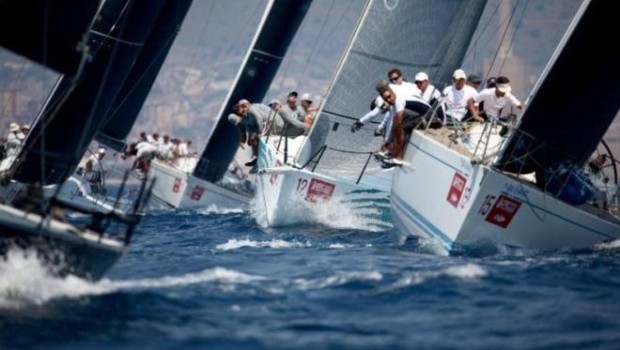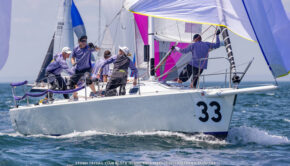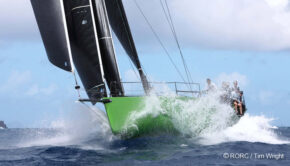Leadership Needed for Handicap Racing in USA
Published on October 13th, 2015
Few organizations have as much impact in the sport as Storm Trysail Club. The strength of STC is in its membership, expert sailors whose inclusion is by invitation only, whose wisdom has influenced the development of new events, handicap rating systems, yacht design, safety procedures, and new rum drinks.
Previous STC commodore Dick Neville is a key contributor. Co-chairman of the 2015 Annapolis-to-Newport Race and chairman of the upcoming Annapolis Fall Regatta, Neville is a long time PRO of Block Island Race Week and will be the race committee chairman for 2016 Key West Race Week.
Scuttlebutt editor Craig Leweck checks in with Neville regarding handicap racing in the USA:
The handicap landscape in USA is complicated, and has been for some time. There are lots of choices, with attempts to gain a consensus never fully getting there. Why is this?
Partly accidental, partly intentional. Geography plays a part, as we have fleets very far apart and rarely getting together. But the situation is magnified by a weak national authority that provides no leadership in this area.
In nearly all well-developed sailing nations, there is a strong central authority who requires membership for participation, adopts policies that can work across their constituencies, and governs in a manner that is clear and responsive. In this context, US Sailing does not serve the most popular system, PHRF, so there are dozens of small PHRF factions, working diligently in a database vacuum, trying to handicap boats, while US Sailing has a database (generated from all the other rules) that can take these handicappers out of their tough and controversial calls.
The weakness at the top has allowed various factions to push for their “favorite” handicap rule, which is not necessarily an International Rule. Some regattas in the US, like Key West Race Week, are international events. We would like Block Island Race Week to attract more international entries, similar to Key West. Block Island Race Week has great PHRF participation, but the customers are not all happy with their handicaps, as the customers come from a diverse group of PHRF fleets.
Are choices a good thing? Do choices encourage participation or do they create confusion which impacts participation?
I think we have proven that too many choices do not encourage participation.
Storm Trysail Club is now advocating a new choice, ORC. Why is this?
Without a National PHRF system, regional events that would like to attract PHRF type entries from outside the local PHRF domain have resorted to PHRF consortiums comprised of PHRF handicappers from various PHRF regions. These consortiums have tried to handicap entries, and while they have worked very hard and we should applaud their efforts, it has not been successful.
Participation in PHRF at Key West Race Week has continued to drop. We see ORC Club as a solution to this problem. For a similar cost to a PHRF Certificate, a boat can be rated by an International Rule and receive a certificate with multiple ratings for variations in wind strength and for inshore and offshore courses. This then has a better chance to fairly rate boats of different types competing in the same class.
Editor’s note: Ninety-eight teams from a record 22 countries competed in Spain at the 2015 ORC World Championship, the only offshore world championship sanctioned by the International Sailing Federation (ISAF).
What’s it take to get an ORC rating?
The rating application is web-based and online at www.orc.org/clubapplication. Measurements common to any PHRF, IRC, or ORR certificate can be used as data to complete the application. The more measurement information provided, the more accurate the rating will be. US Sailing is going to issue the certificates for US applications, and they said they will open a portal on their website, but this has not happened yet.
Editor’s note: This portal is now available here.
Isn’t ORR being promoted by US Sailing? Why not get behind ORR?
US Sailing has a policy that it does not promote any rule. ORR is not as popular as the ORR promoters would lead us to believe. It is expensive and PHRF customers are price sensitive. It is not a rule that we have anyone asking for. We offered it this year for the Annapolis to Newport Race, because of the crossover with Newport-Bermuda (which uses ORR) and we had 4 entries, 3 of which said they wished they had raced PHRF.
What is the differences between ORR and ORC?
ORC is an international rule and ORC Club is inexpensive. ORC Club provides a simple certificate with multiple ratings that can be understood by a PHRF type customer. ORR is only used in the US, it is expensive and more complex. ORR is a secret rule, and ORC is transparent – the rules, the ratings, test certificates, scoring options, valid certificates, etc. are all available online to everyone.
You can apply for an ORC certificate online, even purchase the VPP if you like. They have issued over 9,000 certificates in 40 countries last year alone, are growing annually by 10%, have over 80,000 measurement records in their database, and have a well-developed system and a responsive staff that we have not seen in any other system. Their championship events overseas have shown to be fair to all boat types – well-sailed racers and cruiser/racers can both win in this system.
What would like to see as the landscape for handicap racing?
One high level international rule as we had in the 70’s and 80’s plus one club level international rule that would allow club level racers to compete in regional regattas, knowing what their rating was before they arrive at the event.










 We’ll keep your information safe.
We’ll keep your information safe.